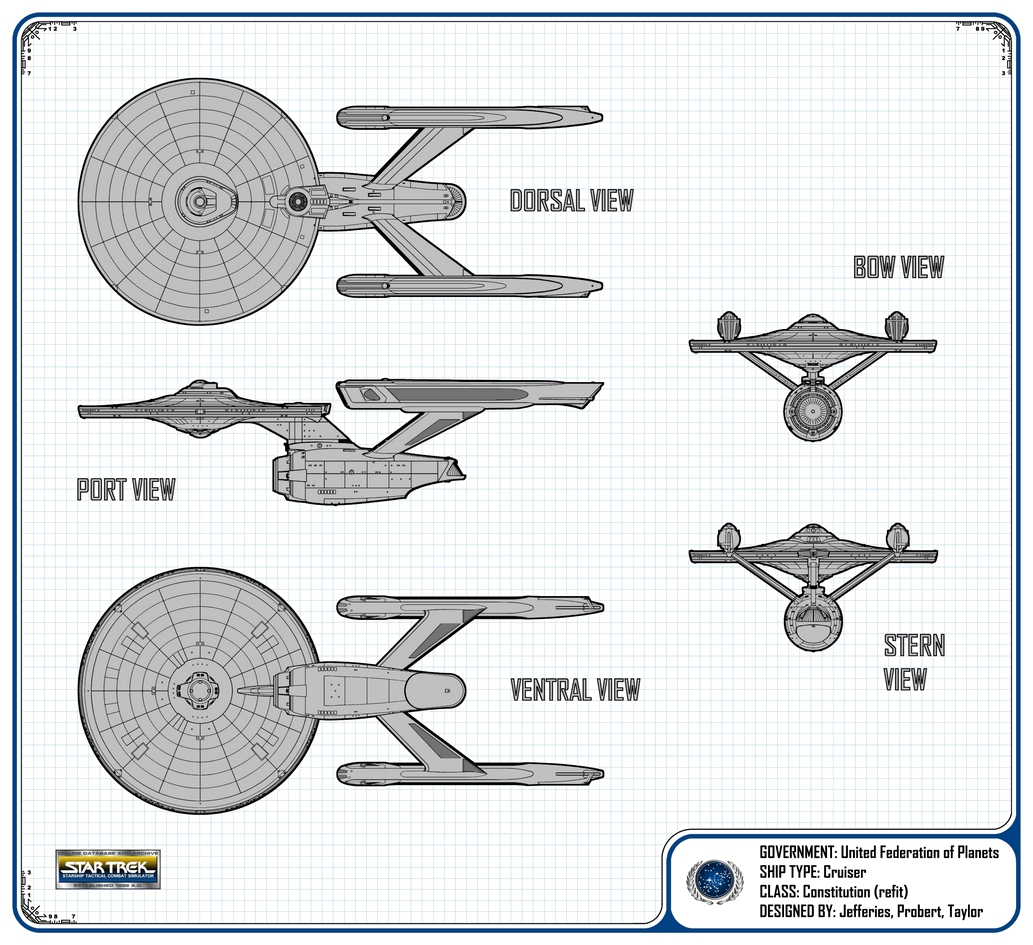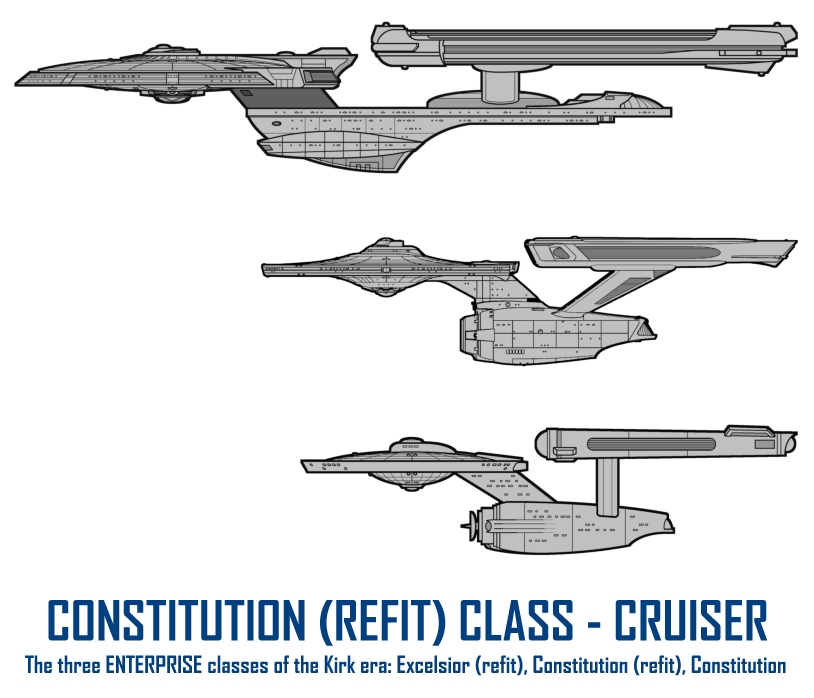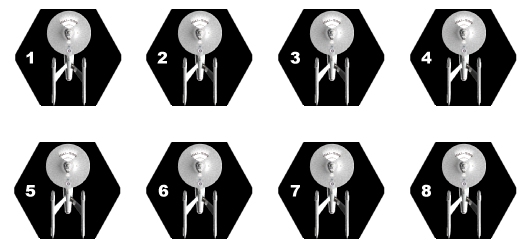![]()
Constitution (refit) Class ● Cruiser ● United Federation of Planets

CLICK ABOVE TO SEE A DOUBLE-SIZE BLUEPRINT
|
THIS HAS GOT TO BE MY ALL-TIME MOST-FAVORITE ENTERPRISE DESIGN! To me,
this ship takes the rudimentary lines of the
Constitution—first laid down for
ST:TOS by Matt
Jeffries and built by Greg Jein—and
maximizes all the best features, while minimizing or eliminating all the dumb
features. Planned for a second, never-to-be-seen Star Trek Kirk-era
television series called Star Trek: Phase 2, the revamped design would eventually be
pressed into service for Star Trek: The Motion Picture. Seen in all six of
the Kirk-era motion pictures—as both the NCC-1701 and the NCC-1701-A—this
design, to me, is simply gorgeous. Matt Jeffries' TOS-era ship was
expounded upon with a streamlined look that definitely brought
Star Trek up to par with its sibling franchise, Star Wars. The saucer looks better, the nacelles and their
pylons look better, the secondary hull looks better, and the hull detailing is
both gorgeous and extraordinary. A fantastic looking spaceship that would take Star Trek off the small
screen and stick it up there on the big screen to compete with the likes of the
Death Star and Luke Skywalker's X-Wing fighter. — BRT
From the FASA Star Trek FEDERATION SHIP RECOGNITION MANUAL, circa 1985 |

| Construction Data: Model Numbers- Ship Class- Date Entering Service- Number Constructed |
MK I XI 2/1704 26 |
MK II XI 2/1910 19 |
MK III XI 2/2102 10 |
MK IV (TNG) XII 2/2802 50 |
| Hull Data: Superstructure Points- Damage Chart- Size Length- Width- Height- Weight- Cargo Cargo Units- Cargo Capacity- Landing Capability- |
26 C 302 meters 131 meters 74 meters 150,275 tons 450 units 22,500 tons None |
27 C 302 meters 131 meters 74 meters 153,275 tons 450 units 22,500 tons None |
28 C 302 meters 131 meters 74 meters 161,008 tons 450 units 22,500 tons None |
32 C 322 meters 131 meters 78 meters 197,543 tons 450 units 22,500 tons None |
| Equipment Data: Control Computer Type- Transporters- Standard 6-person- Combat 20-person- Emergency 22-person- cargo large- cargo small- |
M-6 4 None 4 2 None |
M-6 4 None 4 2 None |
M-6A 4 None 4 2 None |
M-7A 4 4 4 2 2 |
| Other Data: Crew- Passengers- Shuttlecraft- |
412 60 12 |
416 60 12 |
416 60 12 |
422 50 10 |
| Engines and Power Data: Total Power Units Available- Movement Point Ratio- Warp Core Type- Warp Core Output- Stress Charts- Maximum Safe Cruising Speed- Emergency Speed- Impulse Reactor(s) Type- Impulse Reactor(s) Output- |
60 4/1 FWG-1 52 D/F Warp 8 Warp 9.9 FIE-2 8 |
64 4/1 FWG-1 52 D/F Warp 8 Warp 9.9 FIF-1 12 |
68 4/1 FWG-1 52 D/F Warp 8 Warp 9.9 FIF-2 16 |
66 4/1 FTWC-2 50 D/E Warp 8 Warp 9.9 FIF-2 16 |
| Weapons and Firing Data: Beam Weapon Type- Number- Firing Arcs- Firing Chart- Maximum Power- Damage Modifiers +3 +2 +1 Missile Weapon Type- Number- Firing Arcs- Firing Chart- Power To Arm- Damage- |
FH-11 6 in three banks 2f/p, 2f, 2f/s Y 10 (1 - 10) (11 - 17) (18 - 24) FP-4 2 F S 1 20 |
FH-11 6 in three banks 2f/p, 2f, 2f/s Y 10 (1 - 10) (11 - 17) (18 - 24) FP-4 2 F S 1 20 |
FH-11 8 in four banks 2f/p, 2f, 2f/s, 2a Y 10 (1 - 10) (11 - 17) (18 - 24) FP-4 3 2f, 1a S 1 20 |
FH-11 8 in four banks 2f/p, 2f, 2f/s, 2a Y 10 (1 - 10) (11 - 17) (18 - 24) FP-4 4 2f, 2a S 1 20 |
| Shields Data: Deflector Shield Type- Shield Point Ratio- Maximum Shield Power- |
FSP 1/4 16 |
FSP 1/4 16 |
FSP 1/4 16 |
FSP 1/4 16 |
| Defense Factor- Weapon Damage Factor- |
145.2 89.2 |
152.0 89.2 |
162.8 123.1 |
195.76 135.60 |

CLICK HEX GAME PIECES TO VIEW AND PRINT SEPARATELY